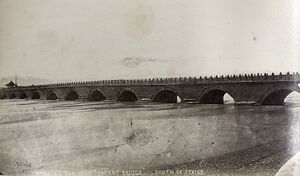Marco Polo incident
 | |
| Date | 7 July 1937 - 9 July 1937 |
|---|---|
| Location | Beijing, China |
| Perpetrators | China, Japan |
| Blamed on | Soldiers |
| Deaths | 756 |
| Description | The official start of the Asian theatre of World War 2, and chronologically, World War 2 as a whole. |
The Marco Polo Bridge Incident or known as the Lugou Bridge Incident (traditional Chinese: 盧溝橋事變; simplified Chinese: 卢沟桥事变; pinyin: Lúgōuqiáo Shìbiàn) or the July 7 Incident (simplified Chinese: 七七事变; traditional Chinese: 七七事變; pinyin: Qīqī Shìbiàn, Japanese: 盧溝橋事件 Rokōkyō Jiken), was an incident that is regarded to have started the Asian part of World War 2.[1] Chinese soldiers fired on the occupying Japanese soldiers during a dispute around a missing solider, controversy is still ongoing on how much of an incident that was.[2]
Official Narrative
| How Going to the Toilet Started a War - The Infographics show |
"In the early summer of 1937, Japan began to carry out military training exercises near the bridge. They always warned the local inhabitants, to prevent panic, but on July 7, 1937, the Japanese commenced training without prior notice to the Chinese. The local Chinese garrison at Wanping, believing that they were under attack, fired a few scattered shots, and the Japanese returned fire. In the confusion, a Japanese private went missing, and his commanding officer demanded that the Chinese allow the Japanese troops to enter and search the town for him. The Chinese refused. The Chinese army offered to conduct the search, which the Japanese commander agreed to, but some Japanese infantry troops tried to push their way into the town regardless. Chinese troops garrisoned in town fired on the Japanese and drove them away.
The national governments of both countries saw the skirmish as an insignificant local incident. Soon, both sides were violating the truce agreement. The Japanese shelled Wanping on July 20, and by the end of July, the Imperial Army had surrounded Tianjin and Beijing. Even though neither side likely had planned to go into an all-out war, tensions were incredibly high. When a Japanese naval officer was assassinated in Shanghai on August 9, 1937, the Second Sino-Japanese War broke out in earnest."[3]
Background
Japan and China were already in border disputes since the Invasion of Manchuria in 1931 and subsequent creation of a puppet state, Manchukuo, with Puyi, the last monarch of the Qing Dynasty, as its absolute leader. The Kuomintang government of China refused recognizing Manchukuo, which didn't work as Japan invaded other provinces just to make up for it.
By the start of 1937 all the areas north, east and west of Beijing were controlled by Japan. The Marco Polo Bridge, located near the town of Wanping (宛平鎮) was an important junction in the Pinghan Railway to Wuhan, and was occupied by the the Japanese military that had repeatedly demanded the withdrawal of all Chinese forces.
False Flag
Whether the incident was planned like the earlier false flag Mukden Incident, is still a point of discussion. Opinions vary by scholars pointing out Japan already was busy with Stalin and the Soviet Union surrounding the island of Sakhalin, while others suggested the Chinese Communist party provoked the incident to wear the Japanese army out.[4][5]
The Official Culprit
| Name | Description |
|---|---|
| Soldier | Military personnel are at the very center of deep state activities. |
References
- ↑ https://www.britannica.com/event/Marco-Polo-Bridge-Incident
- ↑ https://www.vaildaily.com/news/vail-daily-letter-beware-of-false-flags/
- ↑ https://www.thoughtco.com/the-marco-polo-bridge-incident-195800
- ↑ https://books.google.com/books?id=YWLhAQAAQBAJ&pg=PA140
- ↑ https://www.google.com/url?sa=t&rct=j&q=&esrc=s&source=web&cd=&cad=rja&uact=8&ved=2ahUKEwiMo5uX36X9AhXo8rsIHduqAdcQFnoECAsQAQ&url=https%3A%2F%2Fwww.jstor.org%2Fstable%2F2050187&usg=AOvVaw2ZvAdlW88QZUc23HuOvf1H